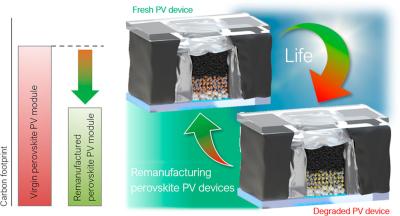Researchers develop "all-in-one" organic ligand for emitting perovskite nanocrystals
Perovskite nanocrystals (PNCs) have considerable potential as next-generation display materials thanks to their excellent photoluminescence quantum yield (PLQY), wide color gamut, and narrow emission bandwidth. However, due to their weak stability against solvents, their patterning remains a challenge. In a recent study, researchers at Ajou University, Hanyang University, Sungkyunkwan University, Macquarie University and Kongju National University developed functional organic ligands (AzL1-Th and AzL2-Th) for the fine pixelation of perovskite nanocrystal (PNC) displays.
Functional ligands containing photocurable azide moieties exhibit good charge transport properties and fast and efficient photocrosslinking performance, while maintaining a high PLQY. The team successfully demonstrated the crosslinked PNC light emitting diodes using AzL1-Th. The results suggest the high potential of photocurable ligands for the micro-patterning of PNC films without film damages.



